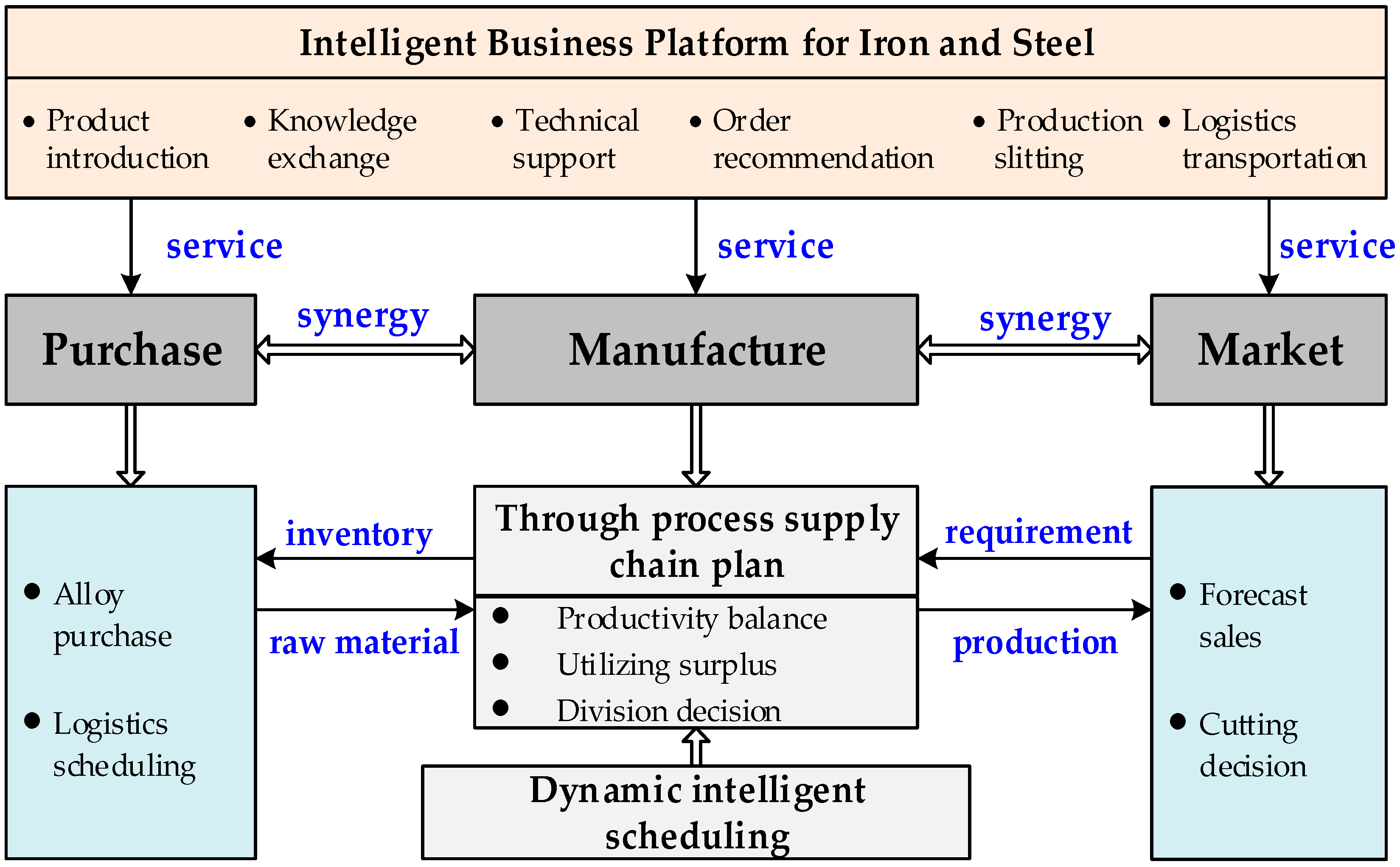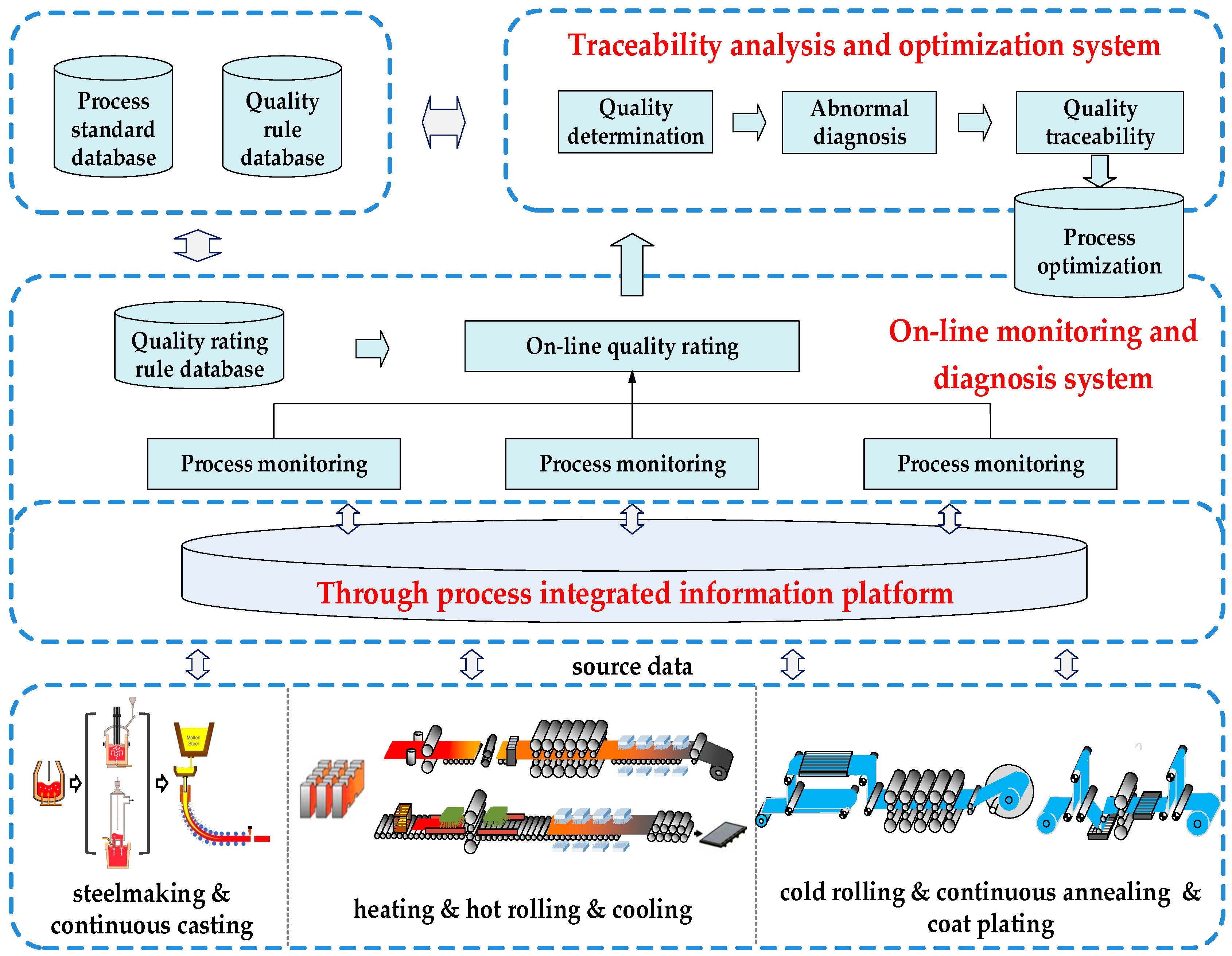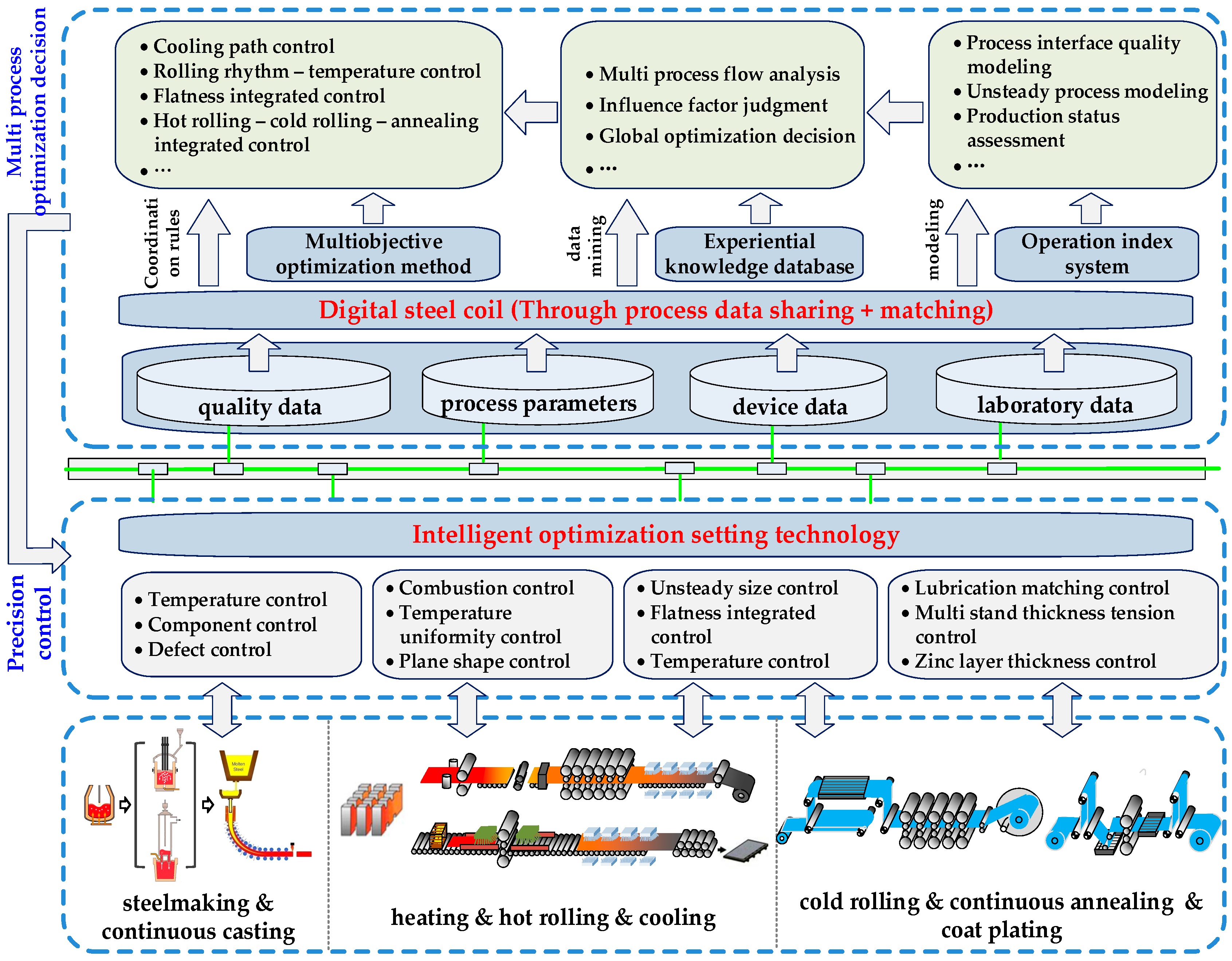Key Intelligent Technology of Steel Strip Production through Process
Abstract
:1. Introduction
2. Collaborative Intelligent Optimization and Dynamic Scheduling Technology for Steel Manufacturing Supply Chain Oriented to Customized Production
3. On-Line Monitoring, Diagnosis and Optimization Technology of Product Quality in the Through Process
4. Coordination and Optimization of Multi-Process and Precision Control of Product Based on CPS Architecture
5. Microstructure and Property Optimization and Surface Quality Intelligent Control Technology in Hot Rolling Process
6. Conclusions
Author Contributions
Funding
Conflicts of Interest
References
- State Council of the People’s Republic of China. “Made in China 2025” Plan Unveiled [Internet]; State Council of the People’s Republic of China: Beijing, China, 2015. Available online: http://www.gov.cn/zhengce/content/2015-05/19/content_9784.htm (accessed on 20 December 2017). (In Chinese)
- Ji, Z.; Li, P.; Zhou, Y.; Wang, B.; Zang, J.; Liu, M. Toward new-generation intelligent manufacturing. Engineering 2018, 4, 11–20. [Google Scholar]
- Kagermann, H.; Wahlster, W.; Helbig, J. Recommendations for Implementing the Strategic Initiative Industrie 4.0; Final Report of the Industrie 4.0 Working Group; National Academy of Science and Engineering (Acatech): Munich, Germany, 2013. [Google Scholar]
- Executive Office of the President, National Science and Technology Council. A National Strategic Plan for Advanced Manufacturing; Report; Office of Science and Technology Policy: Washington, DC, USA, 2012.
- White House Office of the Press. President Obama Launches Advanced Manufacturing Partnership [Internet]; White House: Washington, DC, USA, 2011. Available online: https://obamawhitehouse.archives.gov/the-press-office/2011/06/24/president-obama-launches-advanced-manufacturing-partnershiphtm (accessed on 22 June 2017).
- Foresight. The Future of Manufacturing: A New Era of Opportunity and Challenge for the UK; Project Report; The Government Office for Science: London, UK, 2013.
- Government of the French Republic. The New Face of Industry in France [Internet]; Government of the French Republic: Paris, France, 2017. Available online: https://www.economie.gouv. fr/files/nouvelle_france_industrielle_english.pdf (accessed on 22 December 2017).
- Taki, H. Towards technological innovation of Society 5.0. J. Inst. Electr. Eng. Jpn. 2017, 137, 275. [Google Scholar]
- Wang, G.D. Discussion on innovative direction of entire process and integrated process technology of steel. J. Iron Steel Res. 2018, 30, 1–7. [Google Scholar]
- Boom, R. Research fund for coal and steel RFCS: A European success story. Ironmak. Steelmak. 2014, 41, 647–652. [Google Scholar] [CrossRef]
- Steiler, J.M. Successful collaborative research for the coal and steel, industry in Europe: The RFCS program. Metall. Res. Technol. 2014, 111, 271–279. [Google Scholar] [CrossRef]
- Amaral, R.R. A New SPC Tool in the Steelshop at Arcelormittal Gent Designed to Increase Productivity. Ph.D. Thesis, Ghent University, Brussels, Belgium, 2012. [Google Scholar]
- Polzer, J.; Denker, J. Technology-Based Assistance System for Production Planning in Stainless Mills; European Union: Luxembourg, 2015; pp. 5–10. ISBN 978-92-79-55072-0. [Google Scholar]
- Plüm, H.D.; Torre, V.; Piancaldini, R.; Koschack, U.; Gollhardt, R. Factory-Wide and Quality-Related Production Monitoring by Data-Warehouse Exploitation; European Union: Luxembourg, 2008; pp. 5–12. ISBN 978-92-79-07401-1. [Google Scholar]
- Holzknecht, N.; Fraga, C.; Ferro, F.; Heckenthaler, T.; Nastasi, G. Supporting Process and Quality Engineers by Automatic Diagnosis of Cause-and-Effect Relationships between Process Variables and Quality Deficiencies Using Data Mining Technologies; European Union: Luxembourg, 2013; pp. 5–15. ISBN 978-92-79-33237-1. [Google Scholar]
- Artificial Intelligence-BRS. Available online: https://bigriversteel.com/innovation/ai (accessed on 20 June 2018).
- Ananya, M.; Asif, I. Prediction of Mechanical Properties of Hot Rolled, Low-Carbon Steel Strips Using Artificial Neural Network. Mater. Manuf. Process. 2007, 20, 793–812. [Google Scholar]
- Wu, S.W.; Cao, G.M.; Zhou, X.G.; Shi, N.A.; Liu, Z.Y. High dimensional data-driven optimal design for hot strip rolling of C-Mn steels. ISIJ Int. 2017, 57, 1213–1220. [Google Scholar] [CrossRef]
- Zillner, S.; Ebel, A.; Schneider, M. Towards Intelligent Manufacturing, Semantic Modeling for the Steel Industry. IFAC-PapersOnLine 2016, 49, 220–225. [Google Scholar] [CrossRef]
- Matskanis, N.; Mouton, S.; Ebel, A.; Marchiori, F. Using Semantic Technologies for More Intelligent Steel Manufacturing. In Proceedings of the International Joint Conference on Knowledge Discovery, Knowledge Engineering and Knowledge Management, Rome, Italy, 21–24 October 2014. [Google Scholar]




© 2018 by the authors. Licensee MDPI, Basel, Switzerland. This article is an open access article distributed under the terms and conditions of the Creative Commons Attribution (CC BY) license (http://creativecommons.org/licenses/by/4.0/).
Share and Cite
Sun, J.; Peng, W.; Ding, J.; Li, X.; Zhang, D. Key Intelligent Technology of Steel Strip Production through Process. Metals 2018, 8, 597. https://doi.org/10.3390/met8080597
Sun J, Peng W, Ding J, Li X, Zhang D. Key Intelligent Technology of Steel Strip Production through Process. Metals. 2018; 8(8):597. https://doi.org/10.3390/met8080597
Chicago/Turabian StyleSun, Jie, Wen Peng, Jingguo Ding, Xu Li, and Dianhua Zhang. 2018. "Key Intelligent Technology of Steel Strip Production through Process" Metals 8, no. 8: 597. https://doi.org/10.3390/met8080597




